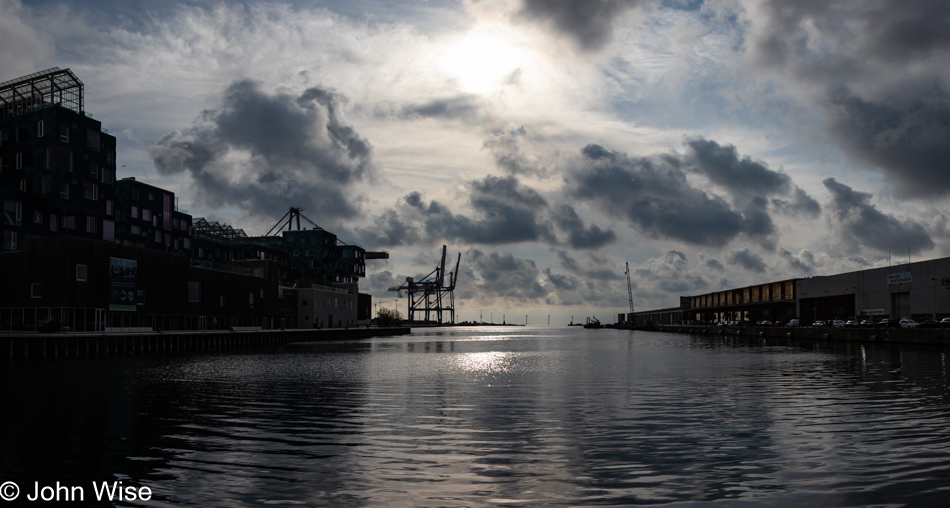
Word of the hour: Tolerance.
“When in Rome, do as the Romans” does not hold true for my fellow Americans when they are out and about. They are tone-deaf to those around them. American and Chinese people must be some of the most brand-conscious label shills, whereas most of the other nations represented here aim for a more understated conservative appearance. The Europeans smoke more, so they don’t get a free pass, but the “just left the gym” look needs to be left Stateside. There sure are outliers here in Europe, but the vast majority do not look to emphasize the slovenly, downright stupid look that so many Americans display. Combined with their booming voices, they demonstrate they’ve just arrived from the United States of Vulgar. This monicker holds fast in the same way yoga pants grip the pubis, which should be reconsidered as proper attire worn in shared public spaces such as here at breakfast in our hotel on a Sunday morning.
I’m not asking for or stating that I need tolerance, as I am old and beyond hope. I’m asking that others should exercise forbearance for the grumpy old man who (at least quietly) writes about his indignation. I’d like to claim that I’m not begging for conformity, just civility, but I admit that this is a fine line. Maybe people are acting as if they are in Rome after all, except in this age, Circus Maximus is celebrated every day.

Leaving our hotel at the beautiful Nordhavn harbor on the Øresund strait, we boarded the driverless metro at Orientkaj to head into town. While we’ve ridden some line-specific tram routes at airports, I don’t believe we’ve ever ridden an automated subway route.

No hashtag, no QR code, and no info at all as to why this man is sleeping in a storefront window. It seems obvious to me that it’s some kind of art project, but I could be wrong, and it could be a study in psychology or philosophy. Upon returning home, I searched for hints about why this person had turned this shop window into his bedroom, but nothing was to be found.

These structures are known as the Green Towers, and there are two of them in Copenhagen. At one time, they were payphone booths with a dedicated operator, back when the Danes were adopting phone service. Today, they are offering refreshments. Coffee or beer, plus a variety of other food and drinks, are available with plenty of outdoor seating on the plaza, which has me wondering how popular these locations are during the short cold days of winter.
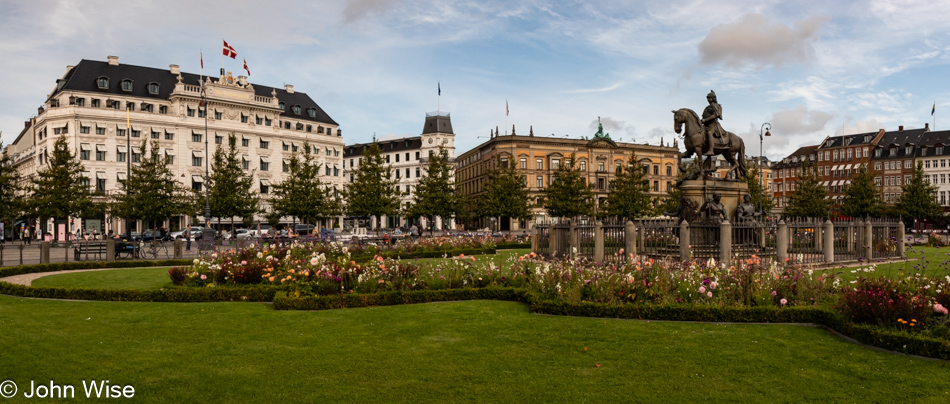
Here at Kongens Nytorv, the largest square in Copenhagen, we once again see Christian V (1646 – 1699), who might have been the most popular leader of the kingdom. Maybe it was his common-man appeal since King Christian V wasn’t considered an educated man and only spoke Danish and German in an age when French was the lingua franca of politics. This limited his opportunity to speak directly with other dignitaries of his stature.
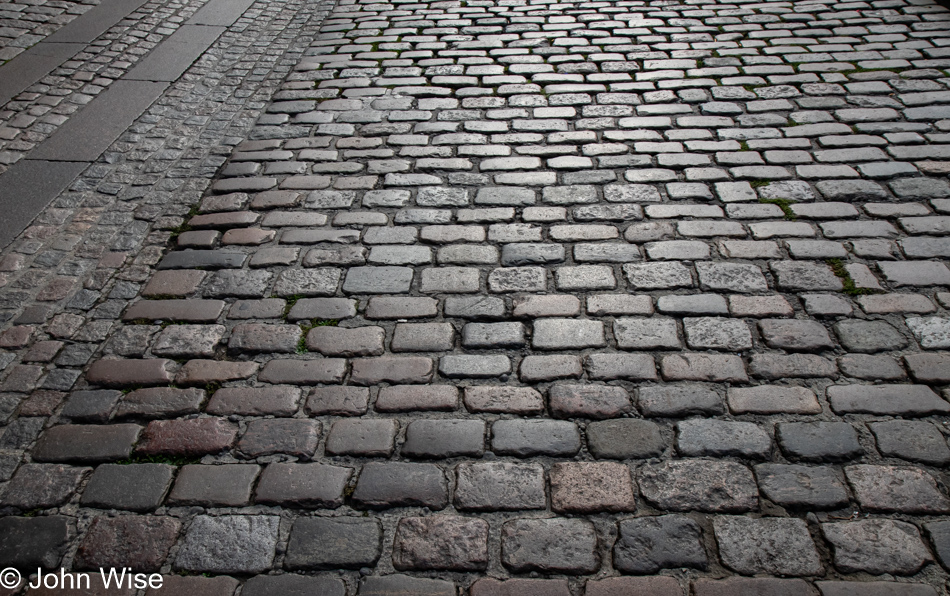
Walking in the footsteps of the tens of millions of visitors who’ve preceded our stay in Copenhagen means we’ll not see anything today that countless others haven’t already. This realization applies to nearly everywhere we’ve been and also will be true for future generations: the only thing possible to change is an individual’s interpretation of their experience in a locale. Then again, what does it matter how anyone else sees anything? As I’ve stated before, this blog is not meant to enlighten others, aside from maybe inspiring someone to see what can be done in a day when one is willing to go hard. Instead, this post and all the others are about reminding Caroline and me where we’ve been, where our feet have hit the cobblestone.
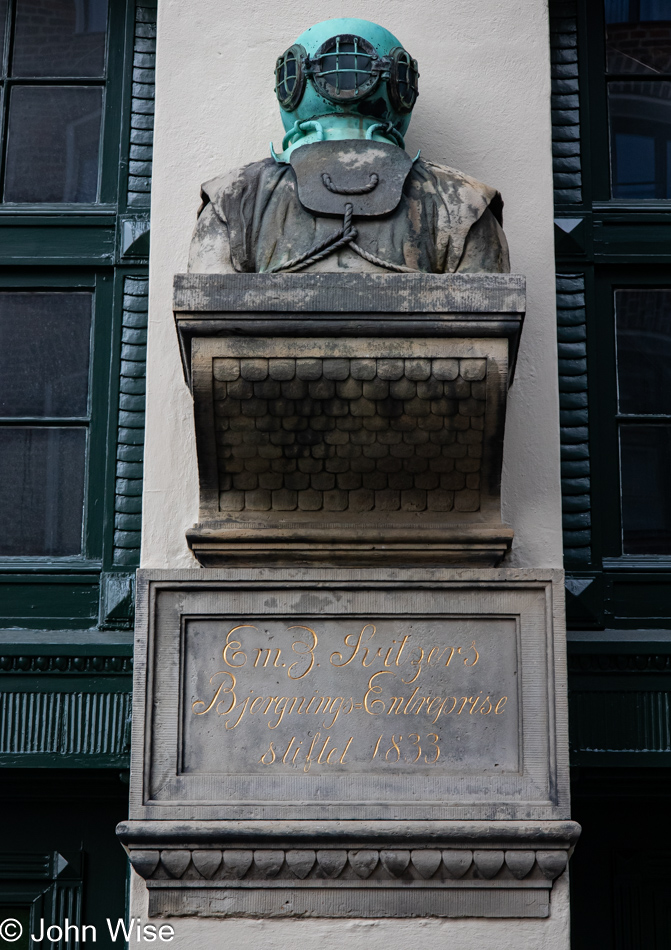
While I blog out here on the internet relatively anonymously, my mark will likely not be remembered for long into the future, unlike Emil Zeuthen Svitzer, who founded a salvage company back in 1833 that became a global entity plying the seas and is commemorated by this gnarly bust of a diver. But that’s okay; I’m only looking to be memorable to my wife and me, and maybe my daughter.
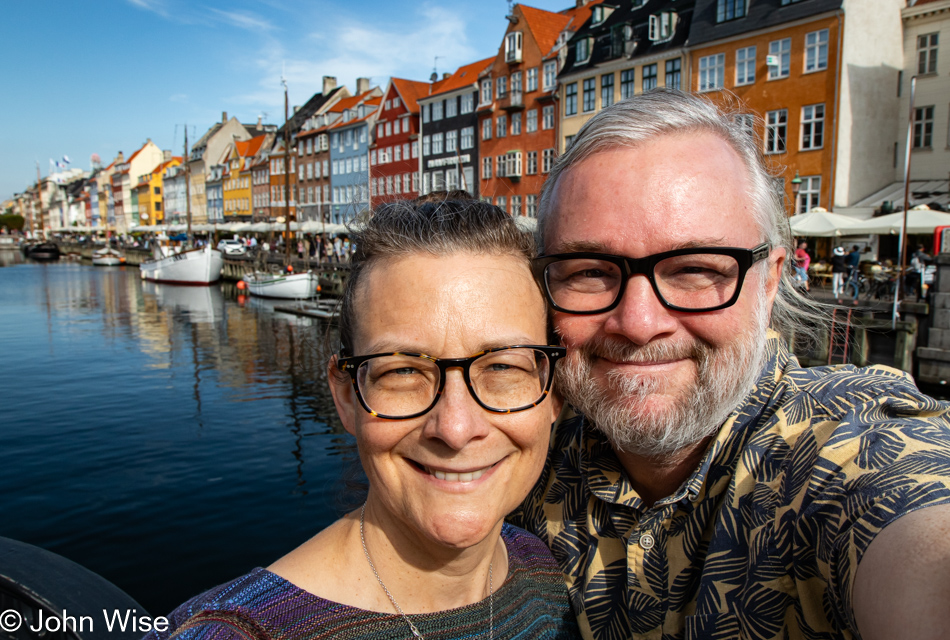
Everybody has to visit Nyhavn when in this city. Here’s my proof that I photoshopped us into the scene.
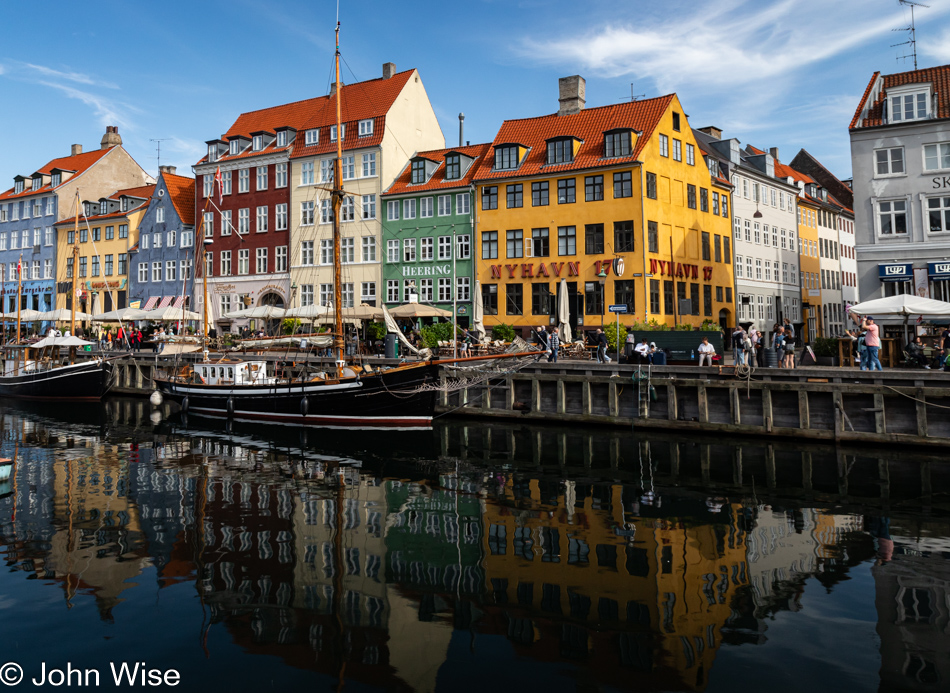
If only I were a professional regarding photography! I would have used the correct lens to not only capture this colorful image of Nyhavn, but I would have been able to properly catch the entire reflection, more of the blue sky, and a wider perspective of it all. Sadly, I opt for expediency and convenience, in part because we are trying to best utilize our time to see and experience as much as possible. Knowing the foibles of memory, we do need the images and musings I am capable of capturing, so something about these days remains in our heads after they have been stuffed full of new impressions.

Welcome to Rosenborg Castle, the former home to six kings, but only for about 150 years. Afterward, the castle would become the repository for the crown jewels and continues in this function to this day.
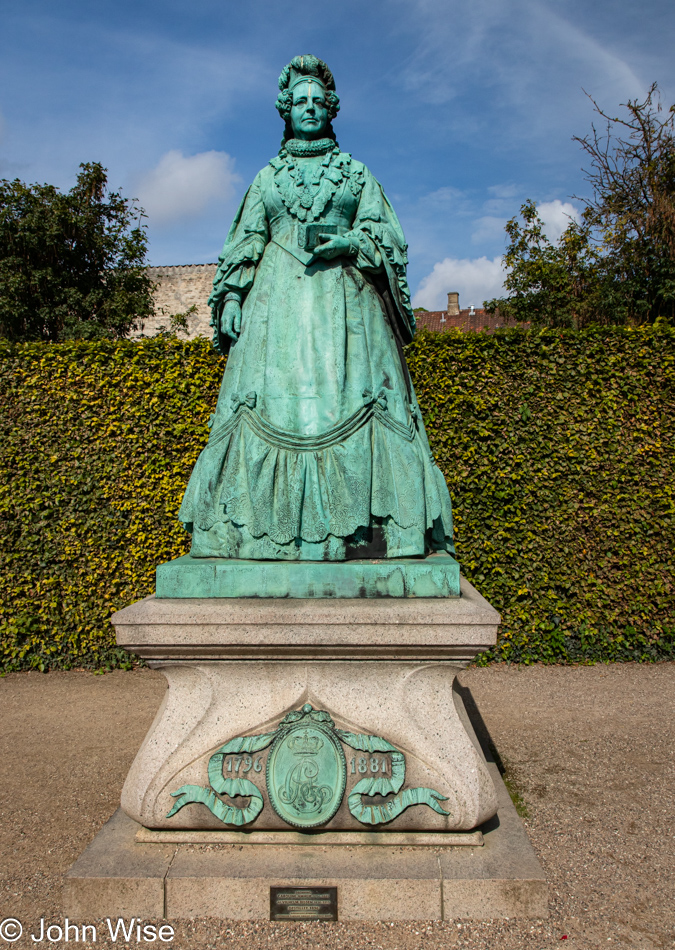
Caroline Amalie of Schleswig-Holstein-Sonderburg-Augustenburg (1796 – 1881) was Queen of Denmark and wife of King Christian VIII (1786 – 1848) from 1839 until his death in 1848, but why she’s here is beyond me because she and her husband lived in Christiansborg Palace. Maybe this was a surplus statue?
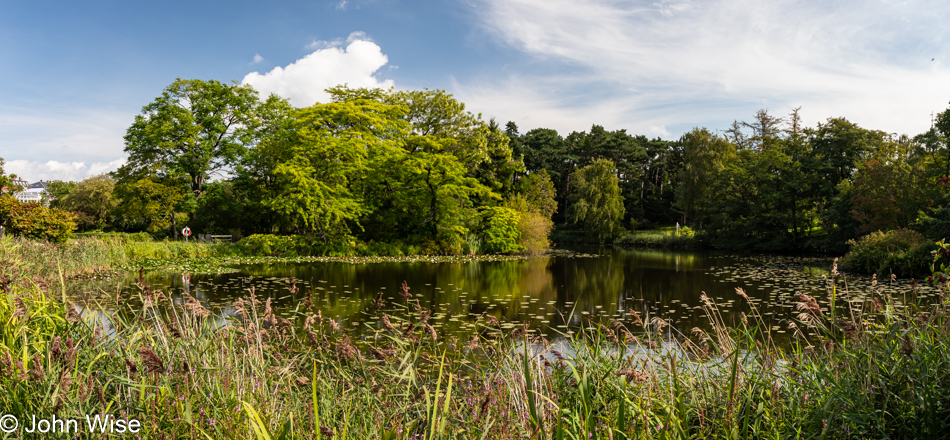
Our idea of visiting Rosenborg didn’t go off as planned, as entries were sold out for about an hour. With tickets for the next available time slot in hand, we walked across the street to find out what we could see in the Botanical Garden. First up was this pond. We had wanted to head into a section behind it that features a statue of famous astronomer Tycho Brahe, but wouldn’t you know that the area is closed for renovations?
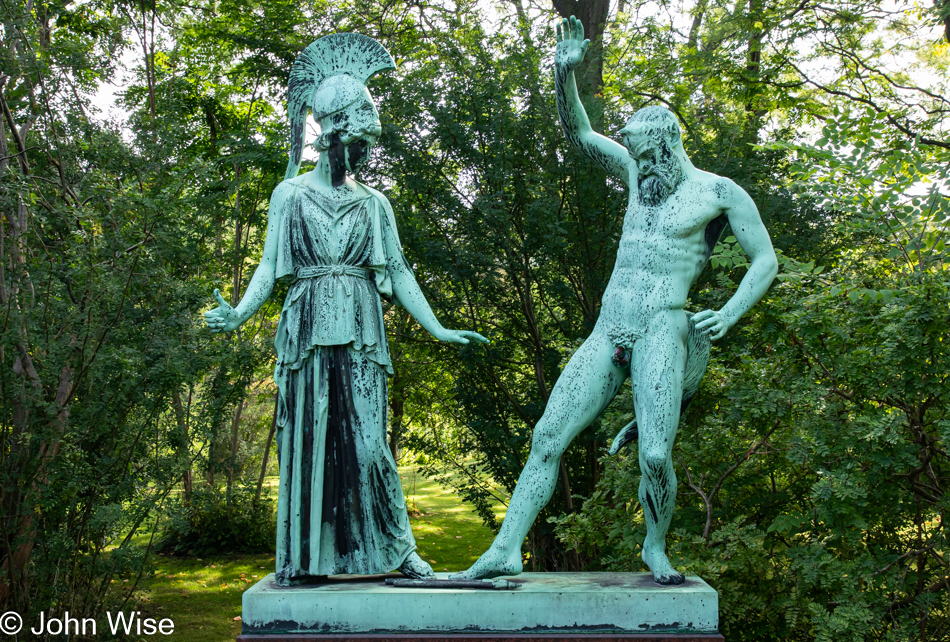
“Behold my micro penis, but if that fails to impress, I have this awesome tail!” – “Meh, I’m at a loss of what to do with your tail, and that tiny thing you call penis that’s lost in your pubic hair does not deserve to be called a penis, and that is that. As a matter of fact, you might want to travel south to the Netherlands, where Zacharias Janssen recently invented the microscope, to see if he can find your diminutive manhood!”

Without a lot of time at the Botanical Garden, we weren’t going to have the opportunity to visit the old palm house built between 1872 and 1874, but we’ll include it on a subsequent visit to Copenhagen should we be so fortunate. Instead, we took a moment to appreciate the grounds and some of the unfamiliar plants before returning to Rosenborg Castle.
Word of the Midday: Patience.
It’s possible that those standing around obliviously or who have formed a wall of people by walking shoulder-to-shoulder are only out traveling for the first time in their lives. Those four Californians talking loudly with their affected gravely vocal fry must have been rewarded for such ugly public displays in their native Los Angeles, making them unaware of how profound their stupidity appears to us, who must endure their petty attempts to look and sound “cool.”
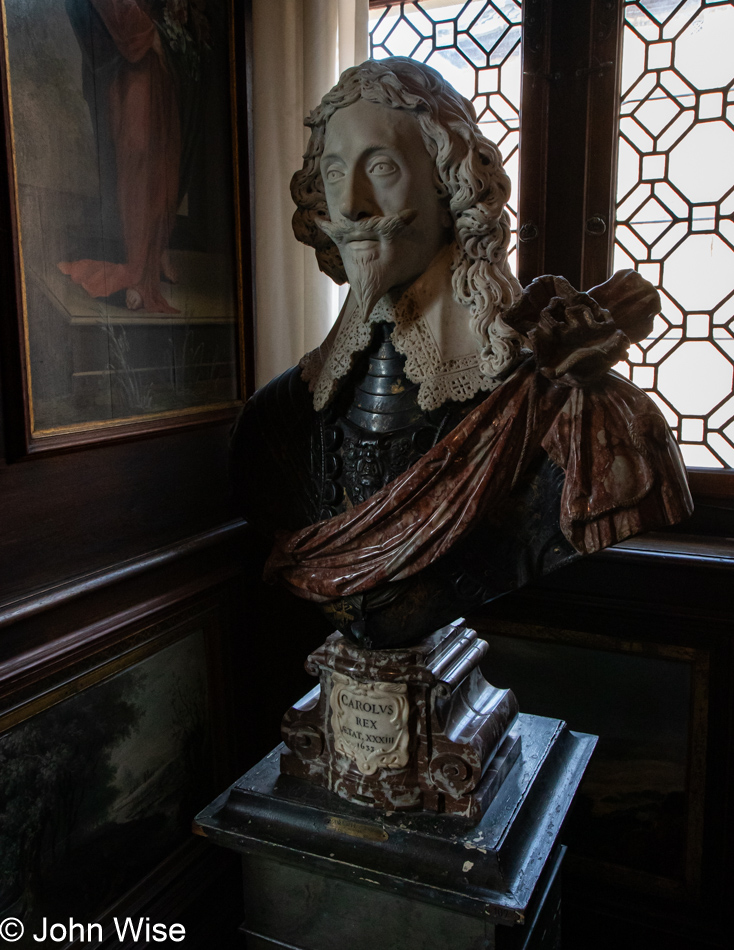
Once inside the castle, all we needed to do was be patient and stick around like this bust of Charles I of England until the pestilence out of California moved on and remained well enough ahead of us that we’d never cross paths again. My apologies for including these particular details, but I’m on vacation, and more than usual, my senses are fine-tuned to bringing everything into mind with the hopes of gathering indelible impressions so when transgressions against civility raise the ugly specter of LOOK AT ME, I’m forced to oblige, no matter my disdain.
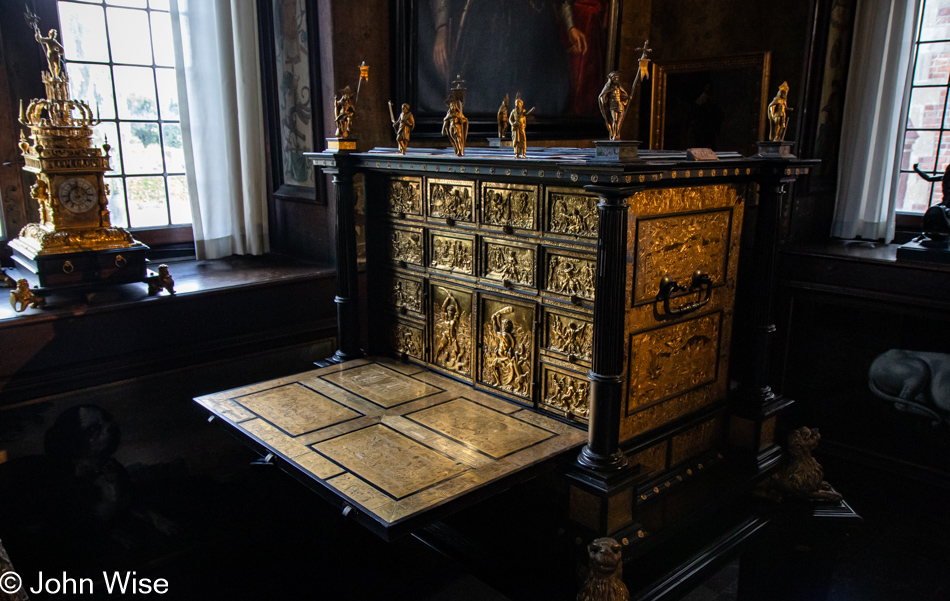
This desk from 1580 was used by Christian IV (1577 – 1648) and would be familiar to him today because it remains where it was when he ruled Denmark so many hundreds of years ago. Unbeknownst to Caroline and me at the time of our visit and sadly mostly out of view, the lions mounted at the tops of the desk’s legs have movable eyes and jaws.
Update: After posting this, I received a reply to an email I sent to the staff of the Rosenborg Castle. A curator was kind enough to answer my question whether there was any video they knew of featuring the movable/animated parts of the desk, and this is their kind response:
“The mechanism is missing, so we don’t know how it worked, but the eyes were rolling, and the tongue moved back and forth. The back of the head can be opened to get access to the mechanism. In the mane just over the “shoulder” is a hole where a key can be inserted and the mechanism wound.”
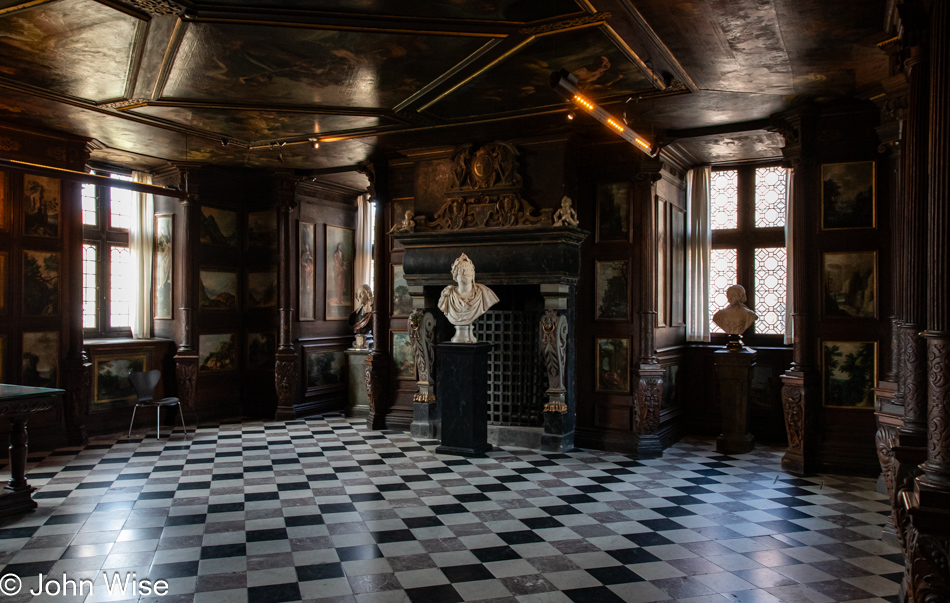
The layout of many rooms in this palace is accurate to what Rosenborg would have appeared like to Christian IV from 1610 to 1648 while he lived here. Many of the furnishings, art, tapestries, and other details were as he set things up during his reign, with his successors making some adjustments but maintaining their authenticity.
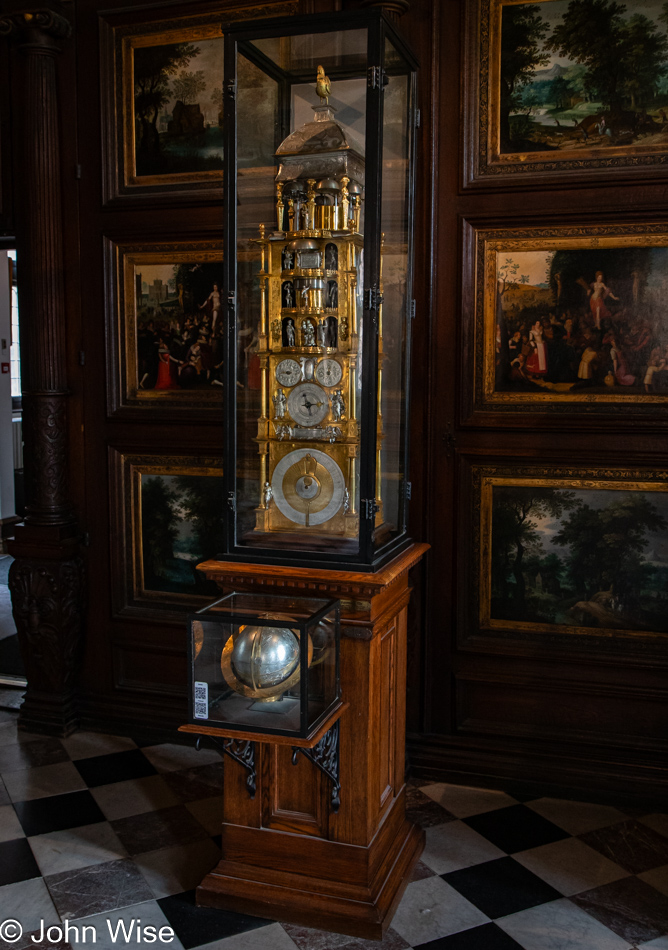
This astronomical clock, built by Isaac Habrecht in 1594, was originally placed at Christiansborg Palace and was only later moved to this location. It turns out that Habrecht and his brother Josias were commissioned to build the 2nd astronomical clock at Strasbourg Cathedral in France based on a design by Conrad Dasypodius. We have visited that cathedral, but the Habrechts’ clock was decommissioned in 1842 and replaced with a 3rd version that is operational to this day. To connect our world of history, we’ve also seen the astronomical clock in Prague, Czech Republic, which is the oldest operating such mechanism, dating from 1410.
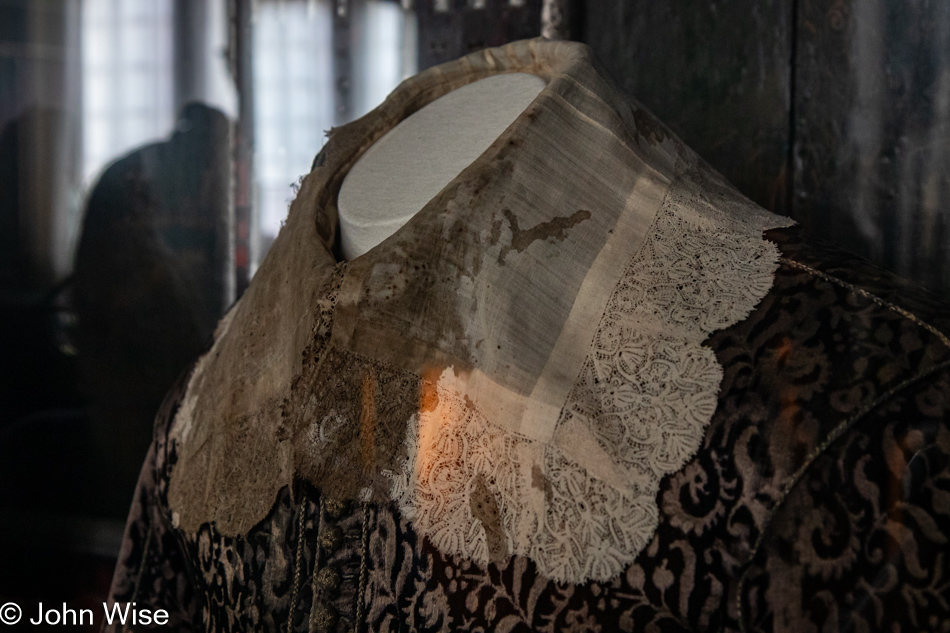
On the 1st of July, 1644, when King Christian IV would have already been 67 years old, he was battling the Swedish Navy on the Baltic Sea near Poland when cannon fragments injured him and took his right eye. After recovering from the initial blow from the wound, he fought on, cementing a reputation of being a warrior king. I find it interesting that he understood the historical ramifications of preserving this gruesome reminder of a nearly fatal injury and that future generations might be interested in seeing his bloodied battle attire.
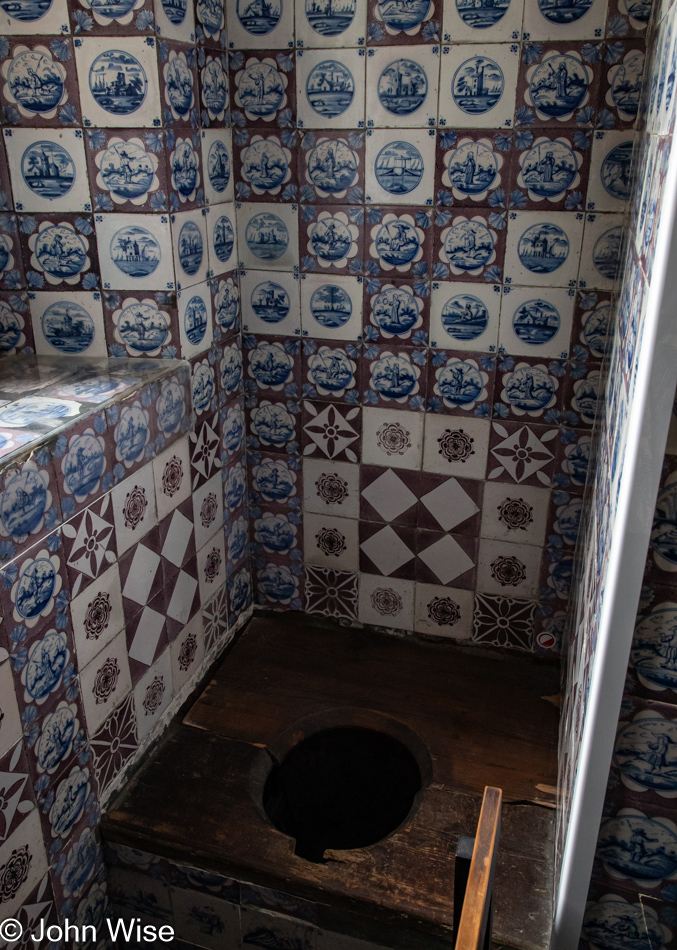
Even kings must move their bowels and while the indoor plumbing drained, it did so into the moat surrounding the castle. This arrangement was okay most of the time and met the demands of the Danish aristocracy’s expectations of luxury, except at those times when the water in the moat evaporated, leaving a steaming pit whose fetid stench wafted back into the castle.
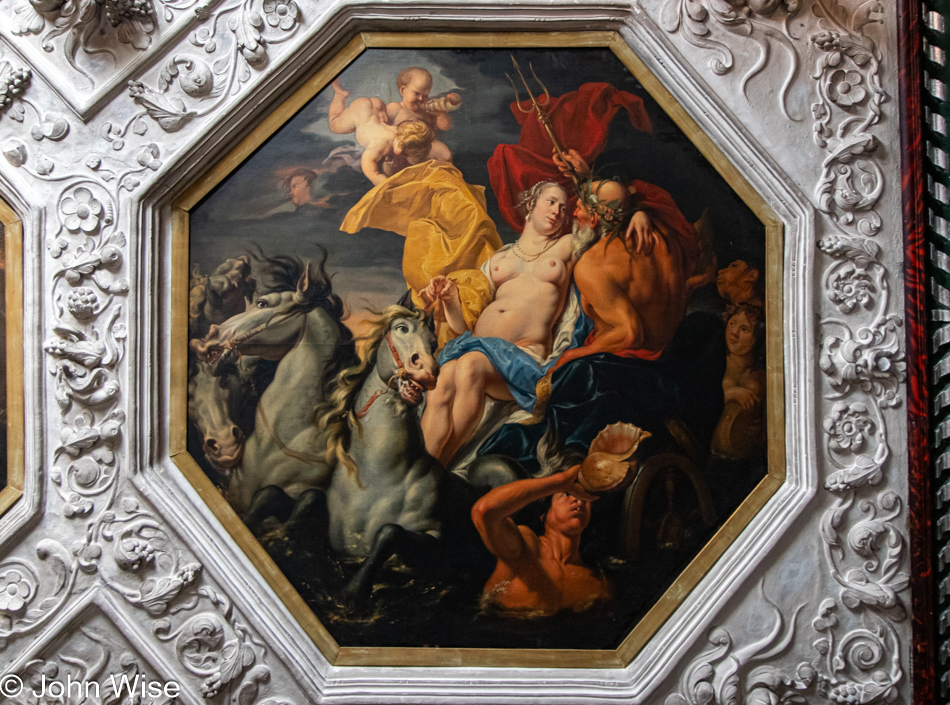
I had to ask my local AI assistant Claude about the significance of the octagon during the Middle Ages, assuming that was the period that influenced the Early Modern when Rosenborg was being built. Well, it turns out that the octagon held geometrical, theological, and even mystical significance for medieval architects and designers as a symbol of order, balance, and harmony.

And here’s the shape again used for a mirror that at one time might have served Queen Anne Catherine of Brandenburg, wife of Christian IV, to see her reflected image, but today it’s showing me my queen, Caroline Elisabeth of Frankfurt.
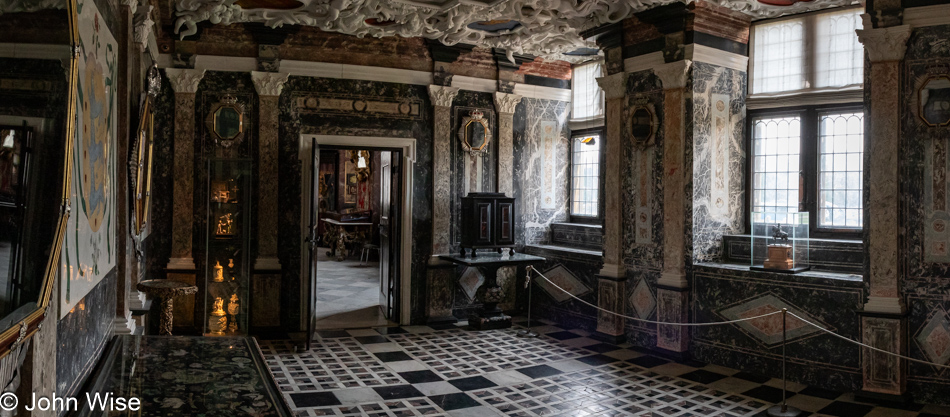
Lingering in wait for others to exit an area allows us to dwell in a space unrushed by some necessity to “see it all” here in Copenhagen. Then, by trying my best to capture images that will prove worthy enough for inclusion, we’ll have points of reference to return to at a time when we can be more considerate of the things we have encountered. Once back home, wanting to offer context to the photos I’m sharing, I end up reading quite a bit about the history and other people’s observations that might complement my post. Caroline comes in at the point where I believe I’m done writing to check my grammar but also ends up fact-checking things as she’s never sure where I took liberties with the interpretation of what I thought I was understanding. Being German, she’s quite the stickler for factual, grammatically correct blog posts. [To anyone reading this blog: I apologize for errors that escaped my scrutiny – Caroline (only human, after all)]
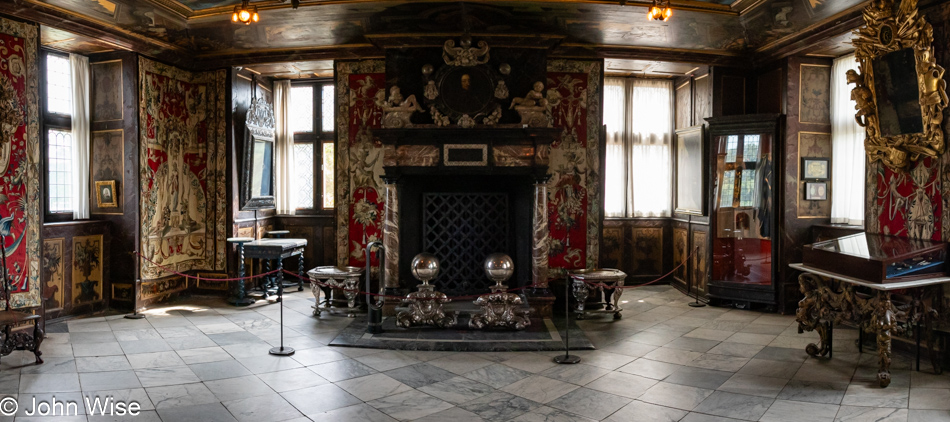
These exercises in planning, traveling, visiting, reading, editing, and the discussions threaded between it all ultimately start to build an evolving body of knowledge that only leads to us wanting to know even more and ultimately make a return visit to better integrate the broad tapestry of pieces all the more likely. We’ve already started looking at books about the history of Denmark but are finding the offerings in English to be rudimentary and not very comprehensive.

Throughout our time in Scandinavia (but not yet at this point in our journey), we noticed that none of the yarn shops in Denmark, Sweden, or Norway featured any tools or supplies to support local weavers and spinners. When asking about this, we learned that weaving in these countries is not really a big thing. (Caroline tells me that there are popular Scandinavian weaving magazines, loom manufacturers, and renowned fiber art schools, but for the casual shopper, this is not apparent). I went looking for where the tapestries in Rosenborg and Christiansborg originated and found that they were often woven by artists in Belgium, and contributions also arrived from France, Italy, England, and Germany. King Christian IV brought Flemish weavers to Denmark to establish local tapestry workshops, but that apparently never truly caught on.
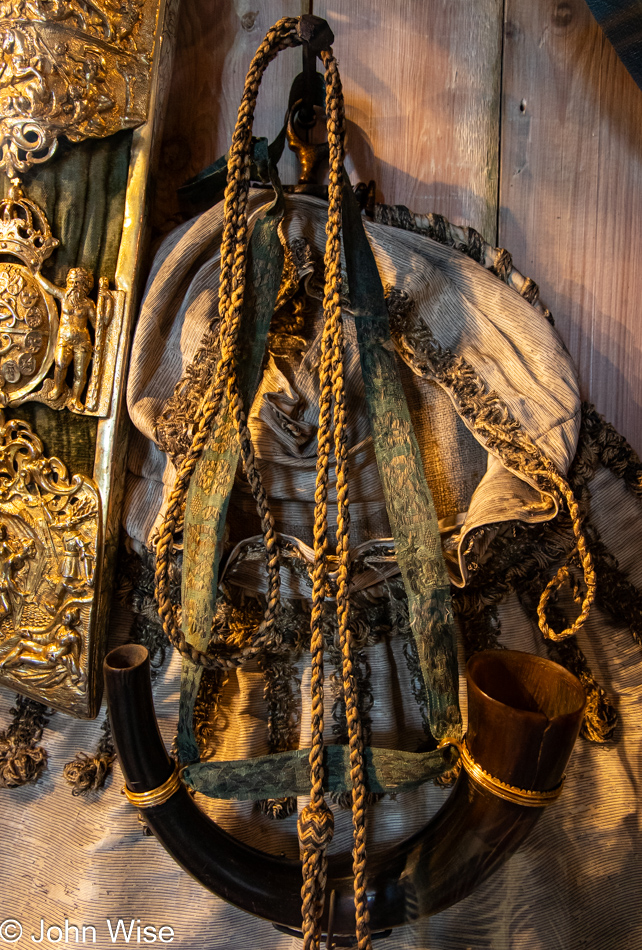
There are a lot of memories embedded in this post that will exceed its casual readability, and while I would like to greatly reduce my self-imposed obligation to offer an extensive record of our adventure, the only thing compromised would be what we can reflect upon. Take this image of hunting gear; I’m not a hunter, and aside from the horn, I can’t identify the other pieces here, but the ensemble of pieces taken as a whole probably looked much the way it did the last time the hunter king hung up his gear not knowing he’d never venture out again.
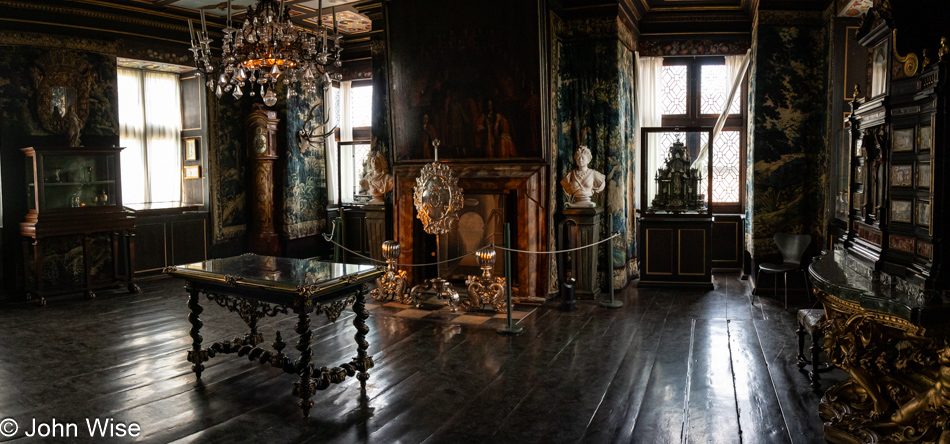
How it is that we can move from room to room without crowds getting in the way, considering the waiting time for entry into the castle baffles me. Moments alone allow me to try and see the space in a way the last residents might have, but no amount of imagination can bridge that gap in time, culture, and knowledge of convenience as I’ve come to experience it.
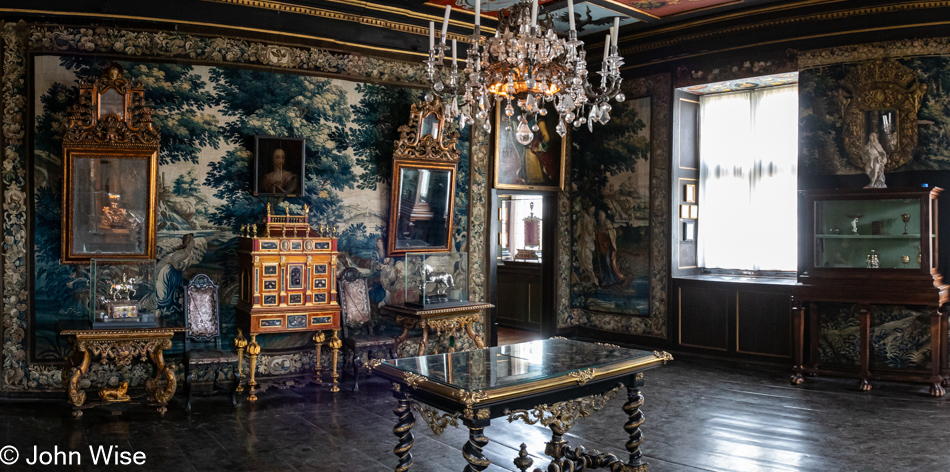
To build ornate structures of memory, words, images, and experiences from a life of exploring knowledge, history, art, music, flavors, sensations, and the diverse impressions we modern humans can pack into our lives fits me like the proverbial glove. If I feel amiss about something that may never be known or possessed, it would be that my limited capacity will forever be denied knowing a fraction of what I desire to understand. There are no riches, objects, or luxuries that could adequately feed my mind or happiness quite the same way if my life was left wanting more than what’s been achieved. I don’t mean to imply that if I were poor, I would have been satisfied with poverty-induced isolation or that if I were left lacking in the opportunity to acquire books and tools that would have allowed me to fulfill my hunger for feeding a curiosity that I could have drawn happiness from those deprivations. Instead, I’m well aware that I’ve always had just enough to remain on the good side of gratitude.
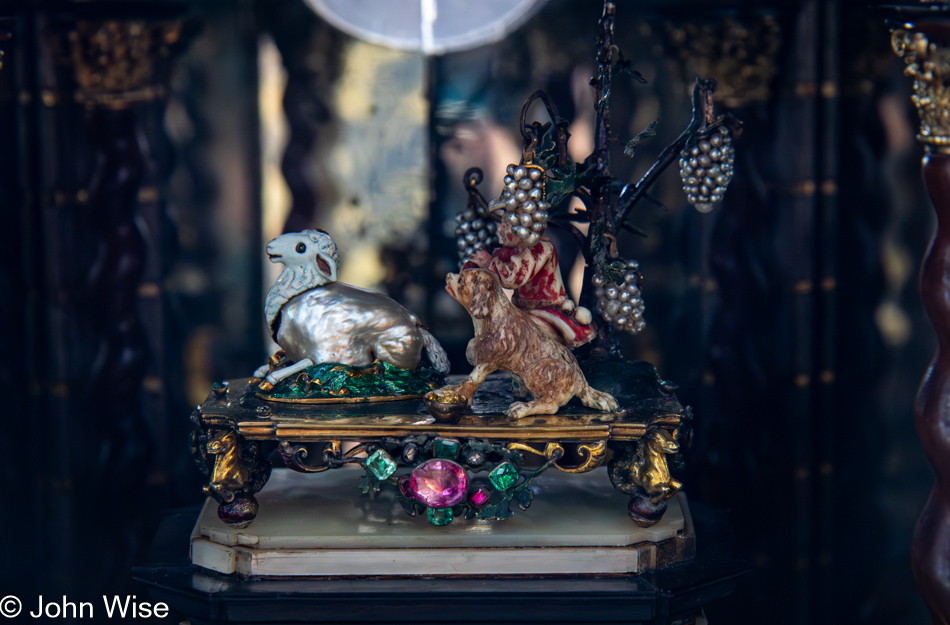
At what moment did the previous residents of this castle ask themselves, when is enough enough?
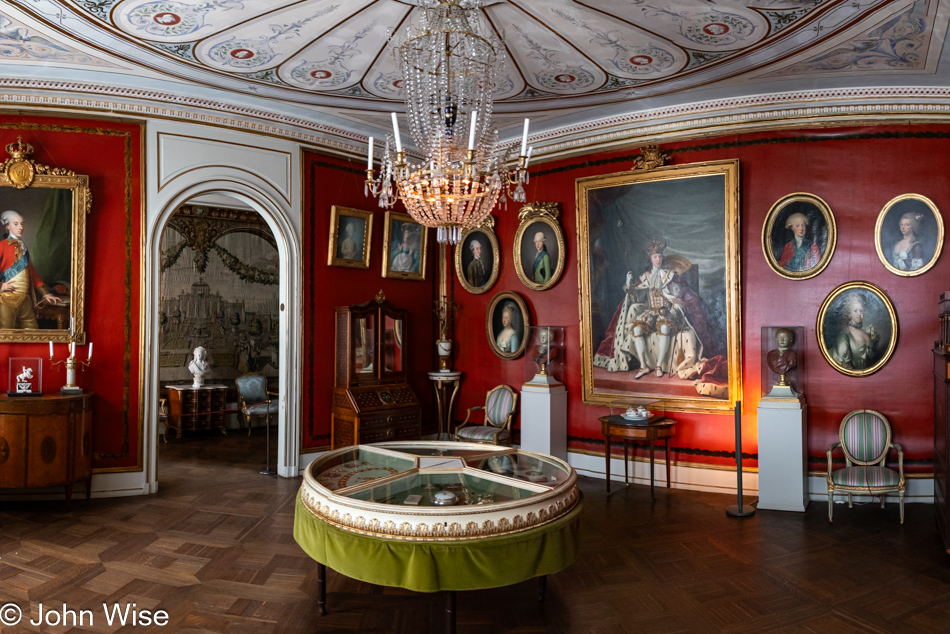
Does someone like Johann Sebastian Bach ever feel like they’ve been able to express music adequately? Did Marcel Proust gain a sense of possessing a formidable vocabulary? Or what about the greatest mathematicians? Did they consider they’d arrived at a mastery over maths? Isn’t there something in those who are trying to achieve the nebulous that their goal is just out of grasp and that if they could seize that unknown piece of wisdom, their efforts would all make sense in some way that might squash their desire for the next thing? Did any king ever find enough? Do the wealthy come to understand the limits of time versus money and what they are ultimately exchanging? Where do the common people learn the extent of what their situation can offer them? “I want it all” seems ridiculous, crazy even.

The Knight’s Hall with Christian VI’s throne at one end…
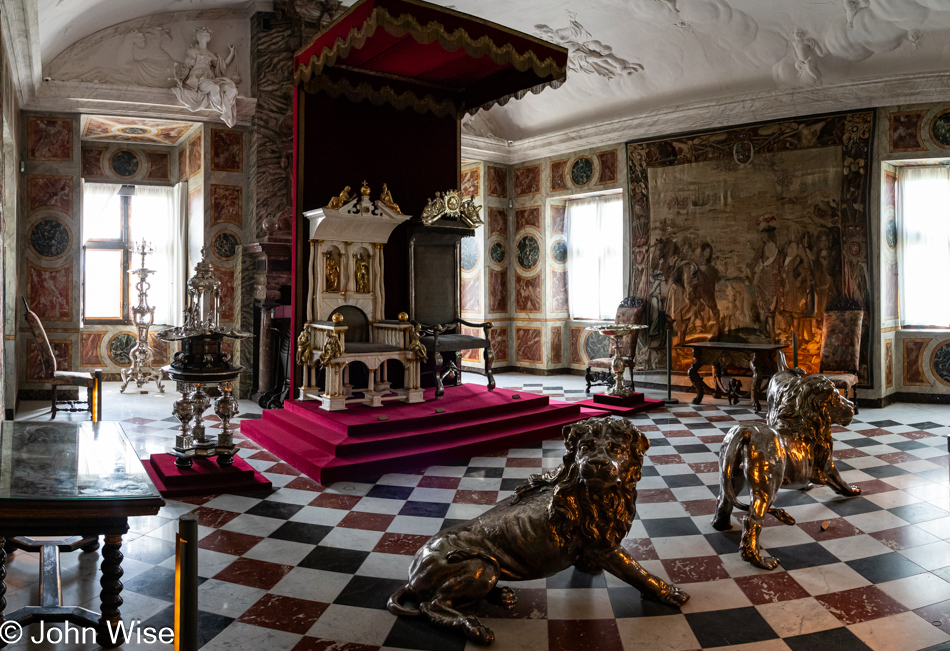
…and the coronation chairs guarded by three silver lions. Note that the chair on the left has been built using four “magical” narwhal horns which at the time were worth their weight in gold.
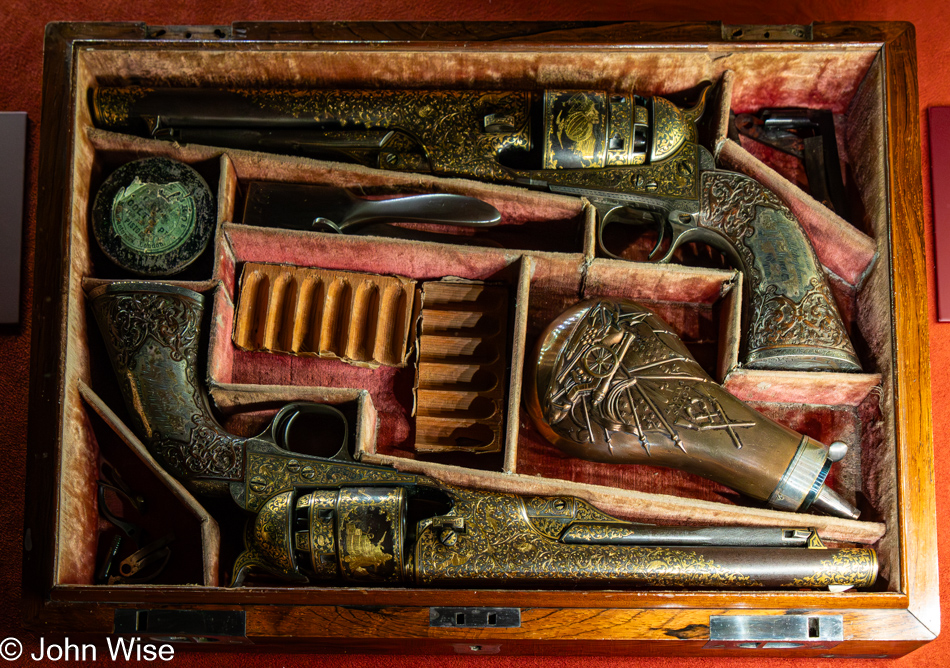
From the upper floors, we moved into the basement that houses the vault that protects the crown jewels and other valuables. These engraved Colt pistols were a gift to King Christian IX from President Abraham Lincoln, and before finding their way into the exhibit, the king actually used them on occasion for hunting.
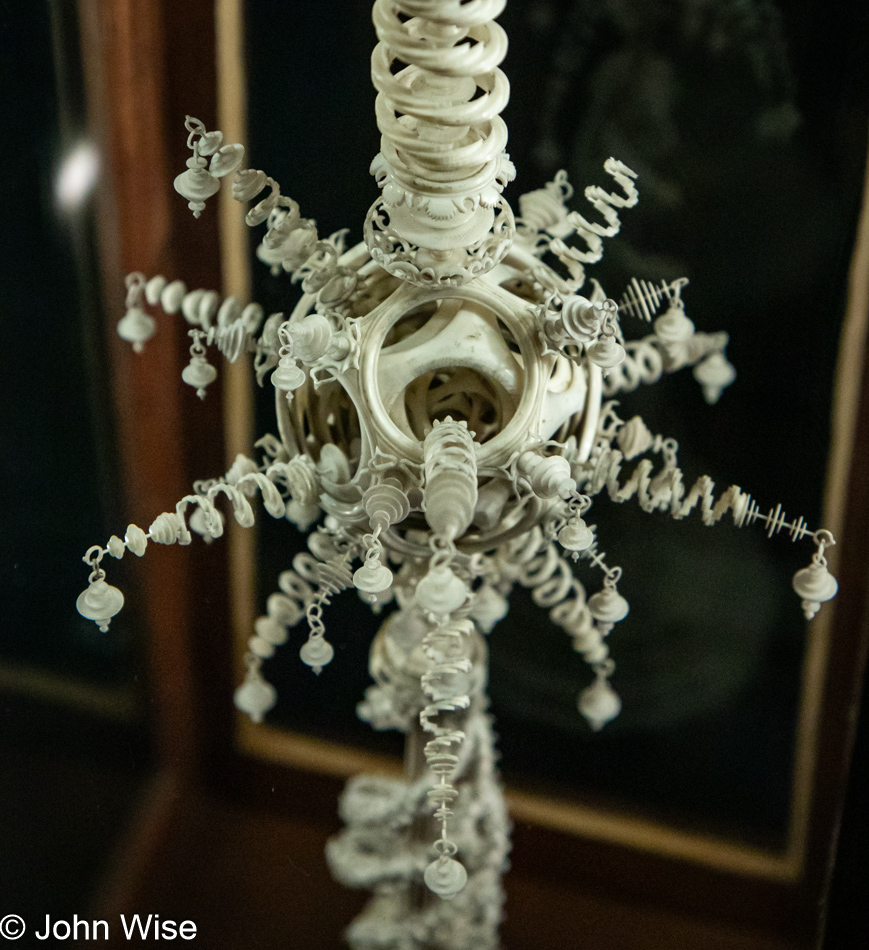
When we humans find that things are exotic and scarce, we put the highest value on those objects. Harvesting ivory, rhino horn, Quagga skin and meat, and tiger parts, we bring those species into extinction or close to it. We’ll allow people to die in horrible labor situations while they are collecting gold, diamonds, or other precious minerals. Today, we offer the wealthy private planes, unlimited property, and inordinate access to resources that we’ll likely look back upon and realize that we were allowing their death cult of wealth to wreak havoc by their exploitation while we worshiped their daring to take advantage of things at our expense. Ideas of divine right have changed little in 1,000 years.
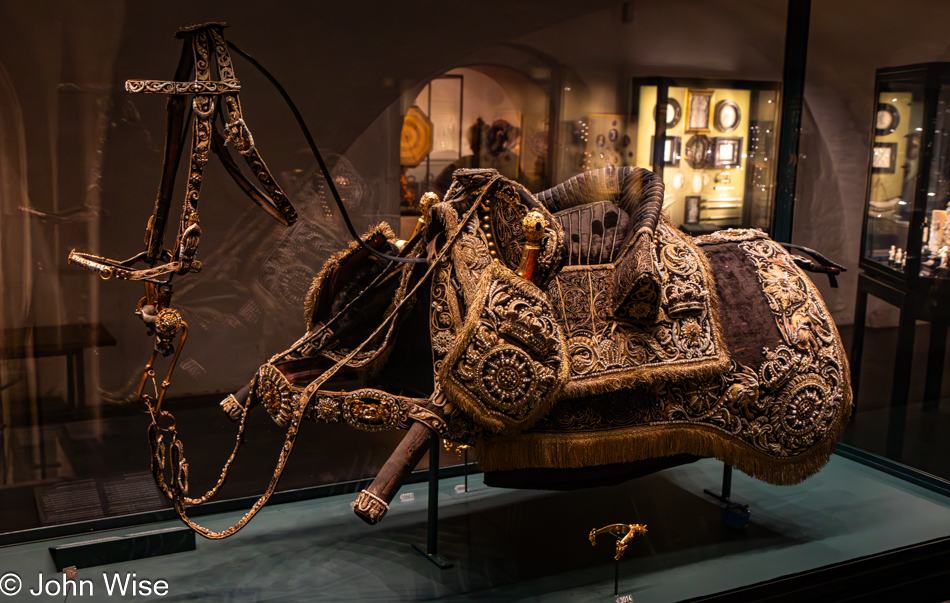
When you need that special saddle for mounting your narwhal on your wedding day.
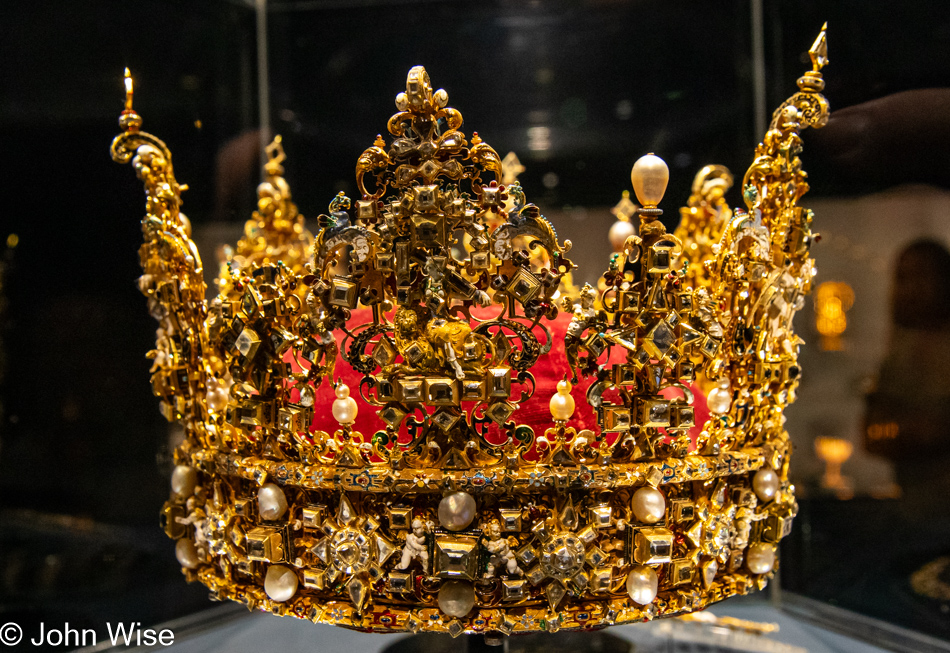
Has anyone else noticed that Donald Trump’s hair has a certain color similarity with crowns? This was the crown of Christian IV while the Orange One only wishes he had one, along with the absolutist rule leaders once had.
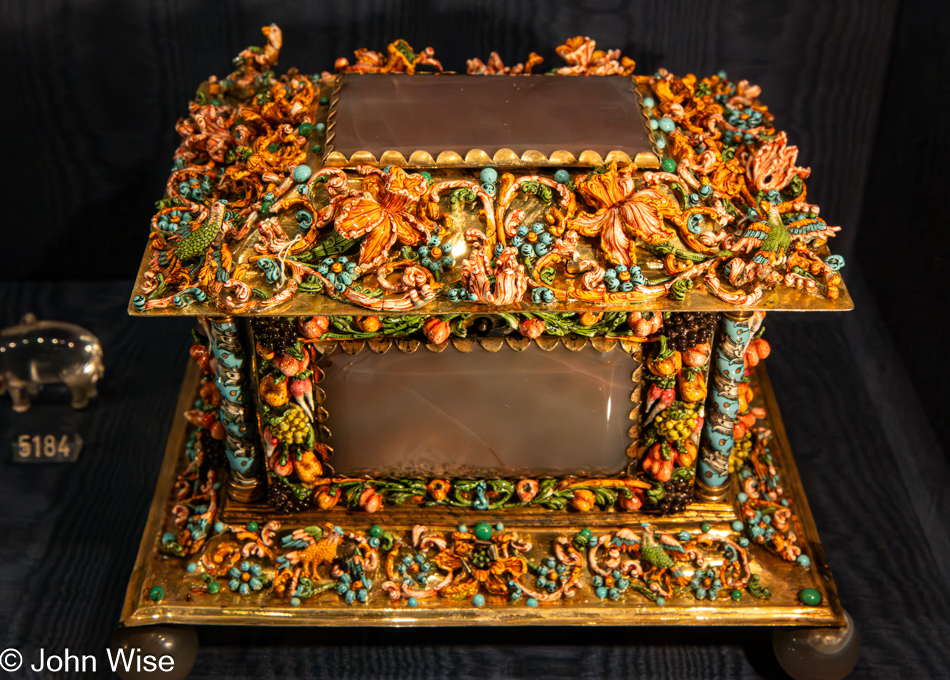
There were two jeweled cases made of silver and agate with enameled flowers in this display case, but it was the one on the right that caught my attention. Both were made by German artist Hans Jakob Mair from Augsburg in 1680. We’ve likely seen his work before, as he apparently created pieces for the Habsburgs, too. I’d like to see this piece as a kind of early television where the king could gaze into the agate and see himself reflected in the polished stone as though he were watching TV.
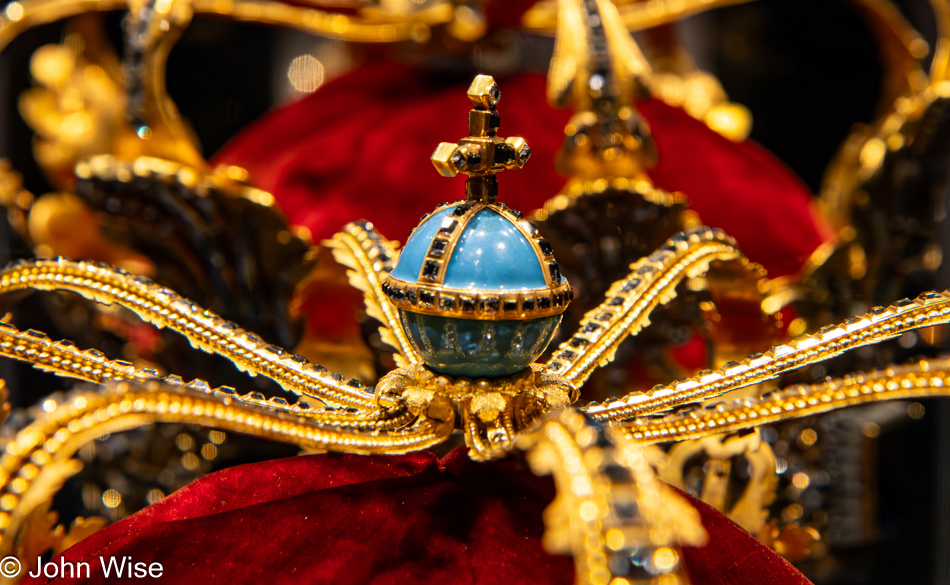
A crown fit for a queen. With that, it was time for us to move on to lunch fit for royalty.

No, this was not the carriage that would bring us to our simple yet luxurious meal at the top of a department store, but I will never fail to be impressed that people can leave $3,500 to $6,000 bikes chained up in public while in the States, we’d have to treat them like they were the crown jewels else they’d be nabbed in a quick second.

Smørrebrød was an instant favorite with us, and now, after having them for lunch for a second time, I can assure you that once back home in Arizona, we’ll make every effort to enjoy them again and again. From left to right, shrimp salad, potato, fried herring with capers and dill, and steak tartar with horseradish, pickle, and egg yolk.

According to one legend, it was botanist Carl Linnaeus back in the day advising important people in high places that the French habit of taking coffee was a threat to Swedish culture that was enjoying a “Kaffi” too. Between 1756 and 1817, coffee was banned on five different occasions; in retaliation, people inverted the word Kaffi and shuffled the syllables to come up with the word “Fika.” To this day in Sweden, Fika is the moment in the day when people stop for a coffee and a sweet and sit for a while to socialize. It is considered one of the essential breaks of daily life. The most common sweets appear to be the Kardemummabullar (cardamom buns) and Kanelbullar (cinnamon buns). We’ve opted to share our first cardamom bun this afternoon, and while we are obviously not in Sweden (yet), we are taking advantage of the opportunity to get a headstart on practicing how to Fika.
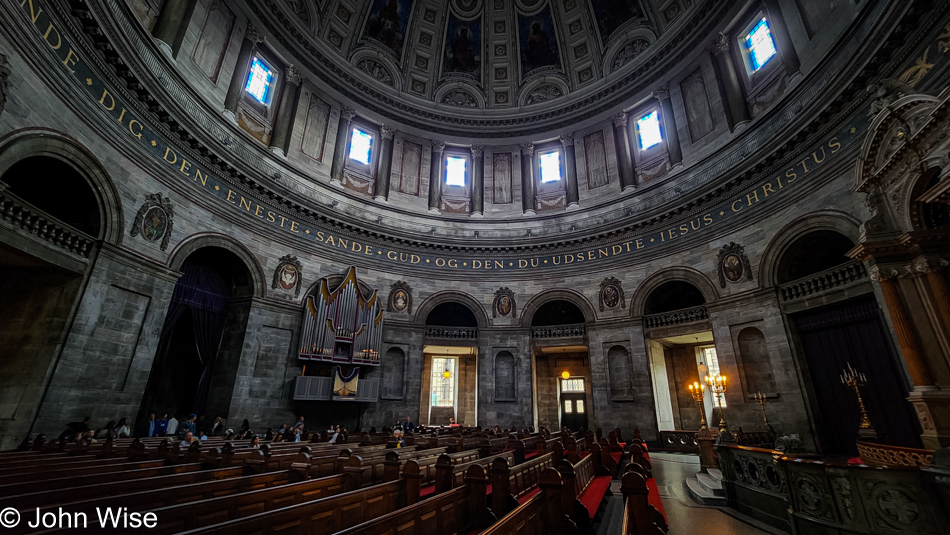
Here I am, well past the halfway point as far as the visual side of this post goes, sharing 3,300 words so far, but what you couldn’t know is that while on vacation, I penned fewer than 350 words as notes for when we got home. We were simply too busy enjoying our impressions and smiling at each other to worry about analyzing how we felt about anything, as happiness to be here was enough to sustain everything else that food didn’t care for. Yesterday, we were too late to visit the interior of Frederik’s Church; today, we won’t miss this opportunity.

This was not an easy place for me to photograph; the first image was from my phone and not my DSLR, this is not the first time I wish I’d brought the wide angle lens for my camera.
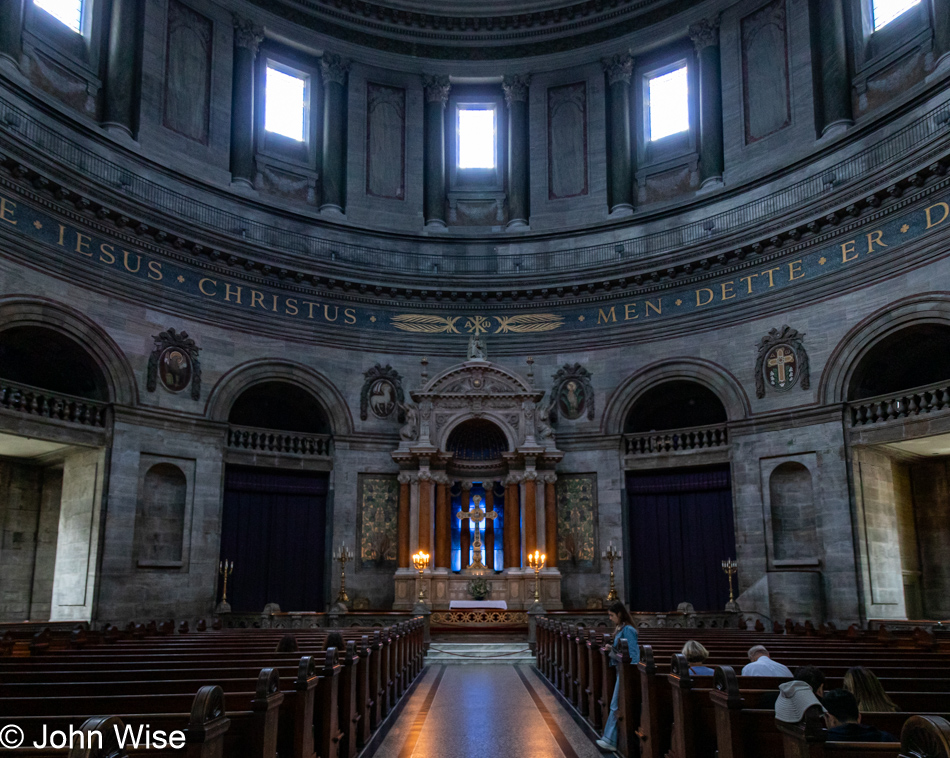
Frederick’s Church was named after King Frederick V, who placed the foundation stone for the building of this monument. Just how this drunkard king managed it is a bit of a surprise, as his alcoholism and hedonism meant he was essentially a failure in regard to governing. His lavish life led to an early death at 42 years old.
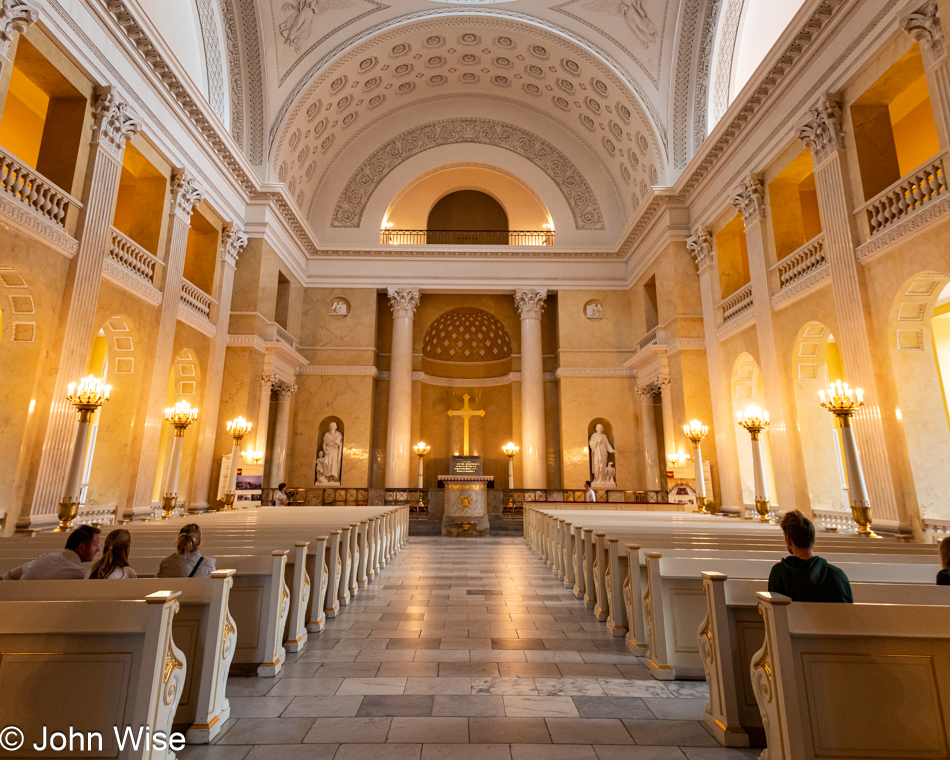
This is the Palace Church that is part of the Christiansborg Palace which we are about to visit. Just like the Fredericks Church, it was designed by noted architect Nicolai Eigtved.
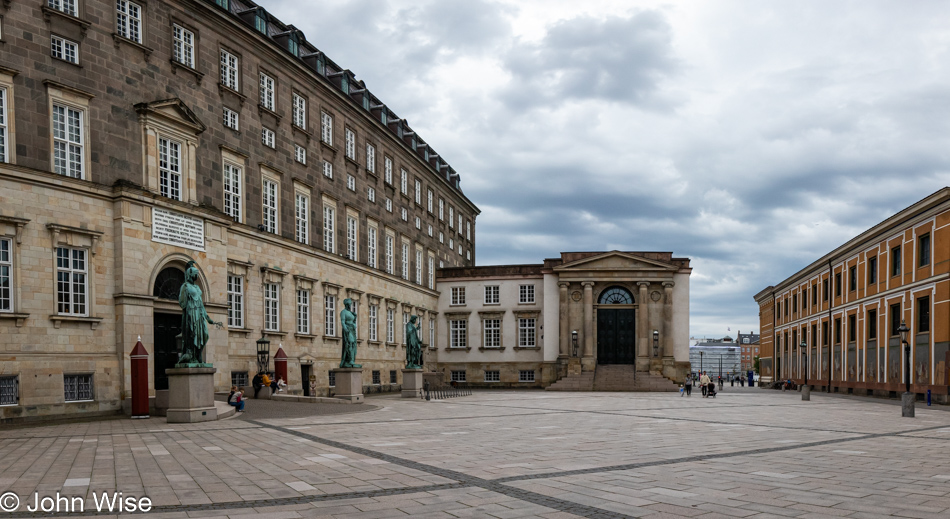
Because one can never visit too many palaces and castles, we are about to step into Christiansborg Palace.
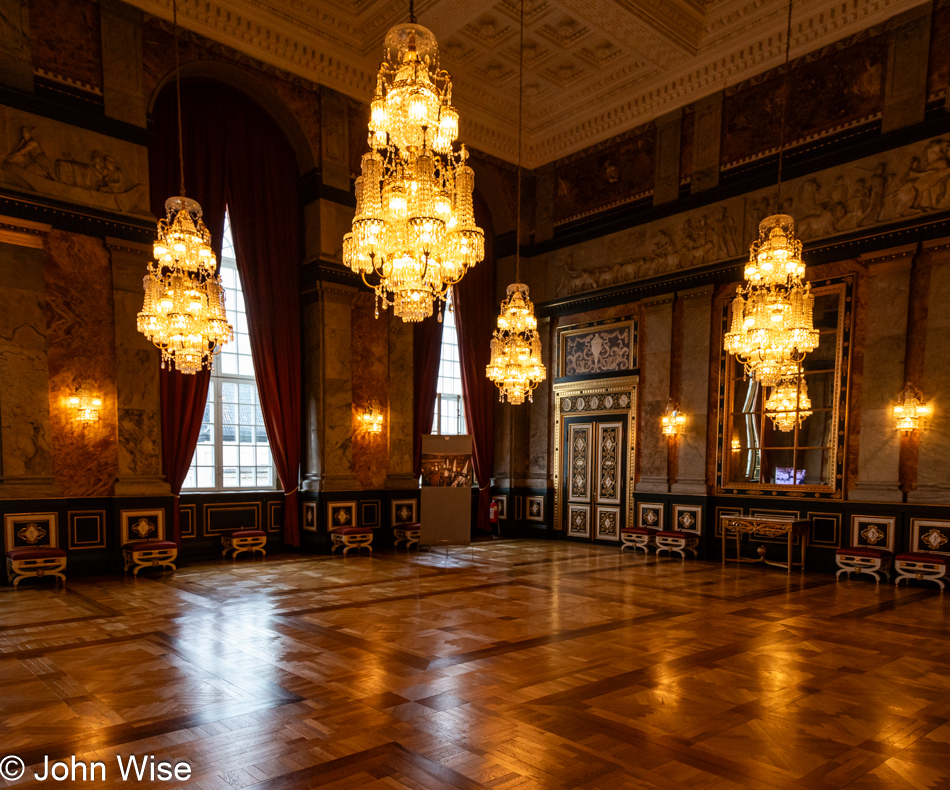
And to be honest, while the space is certainly opulent, it feels like it’s missing the character and personality that Rosenborg had oodles of.
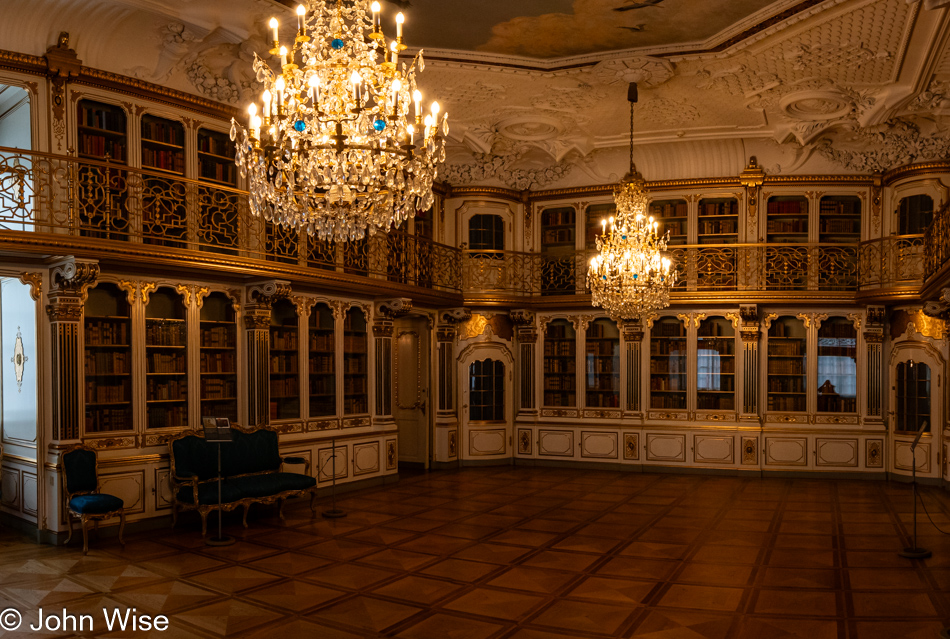
Maybe visiting successive lavishly ornate places one after the other is a bad idea as comparisons are too easily made. Over 35 years ago, I visited Neuschwanstein Castle in southern Germany, and I can’t compare it to anything ever because I hardly remember a thing about the place, not to say we should have waited 35 years between visiting and Rosenborg and Christiansborg as the likelihood I’ve me being alive at 95 years old seems kind of remote.
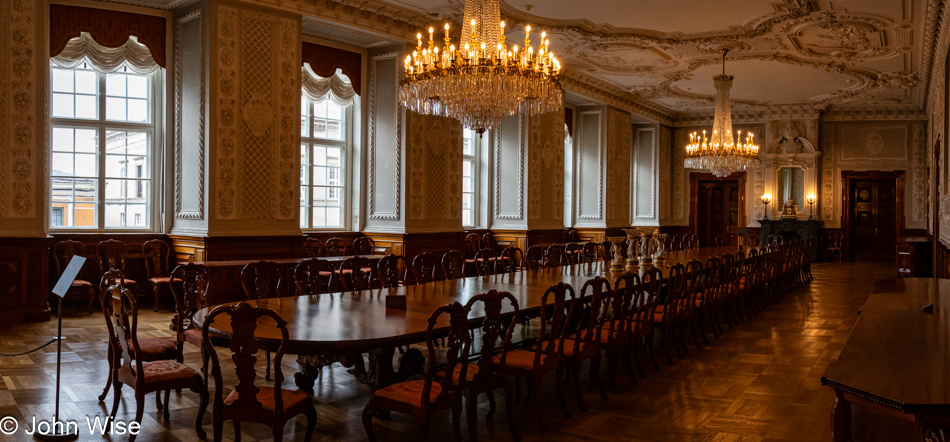
Maybe if we lived in Denmark and were to see these spaces being used for government functions, it would be like visiting the White House in Washington, D.C., where one understands the utility of the space and that it’s not just some giant place that once served a purpose.
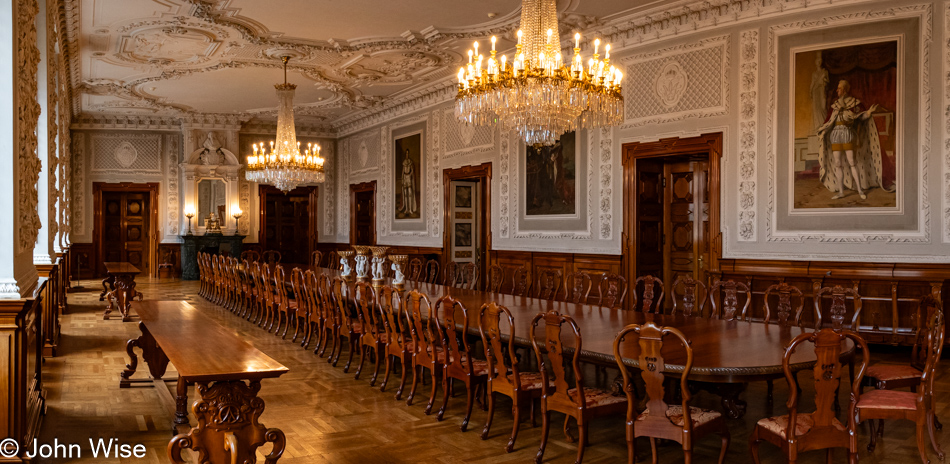
Mind you, this is a beautiful room, and I’m including both photos I took. In the previous angle, I feel that the lighting is perfect, while in this view having the perspective to see the art on the wall offers a better hint of life that’s occupied this palace since it started being used by Danish leaders.

With the palace still used by the government to this day, I suppose I have to understand that it is not, strictly speaking, a museum to house treasures. The space must function as required for official governmental and diplomatic duties, whereas Rosenborg really is nothing more than a repository of Danish treasures and a well-defined historical representation of another age.

Something else that might be impacting my ability to find a vibe is that we are relatively late in the day, and knowing that the clock is working against us means we must rush from room to room and only take cursory glances at the pieces deemed worthy enough to adorn the palace walls, floors, and ceilings. These large-scale tapestries (17 in total) were commissioned for the 50th birthday of Denmark’s current Queen Margrethe II in 2000 and woven by French and Belgian weavers to the designs of Danish artist Bjørn Nørgaard. They took ten years to complete and were inaugurated at the Queen’s 60th birthday in 2000. The tapestries depict different phases of Danish history as well as hopes for the future, and these photos do not do them justice.
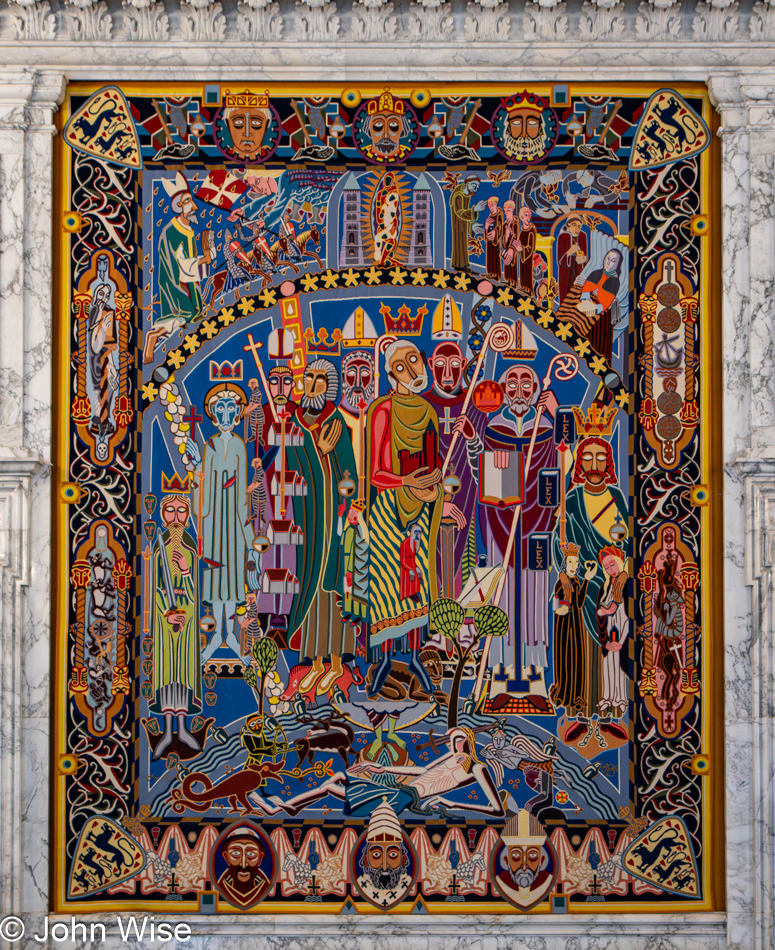
I know there are stories that belong to this palace and that not only do government functions occur here, but the royal family uses part of the palace as a residence. In a race to collect impressions, the larger narrative cannot be known, which has me wondering how, in our day-to-day lives, the race to collect wealth obscures the sight of a better narrative that might otherwise shape healthier and happier lives.
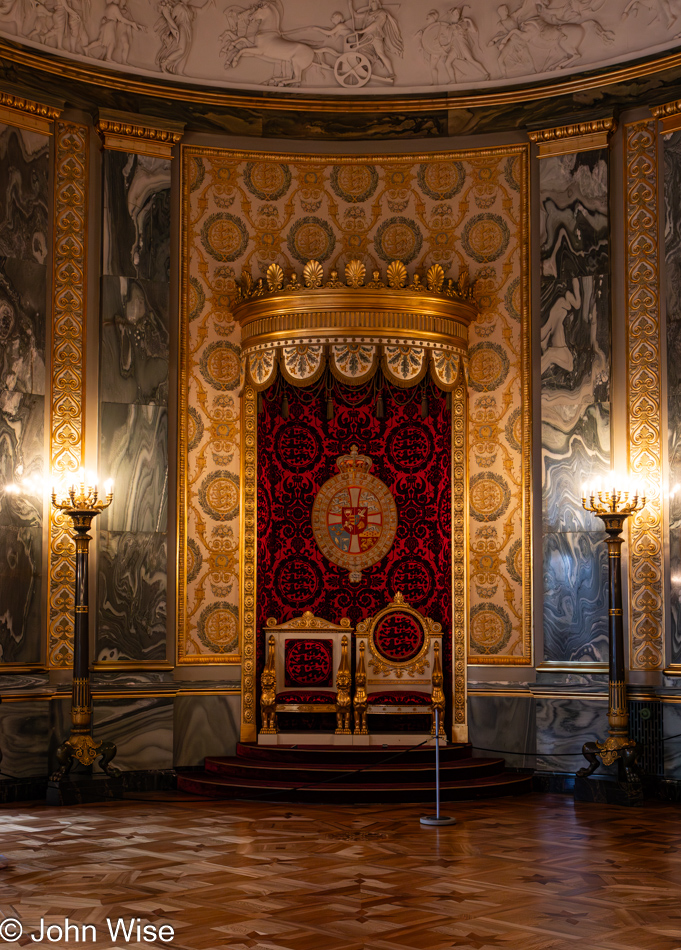
How, in an age of relative enlightenment, do people grow up to accept the titles of kings and queens? The idea that their education hasn’t illuminated their minds to the absurdity of such an idea and that maybe they take the whole thing seriously sounds bizarre to me. Are they not simply actors pretending that they are fulfilling some role on a stage of stupidity where they take up thrones and accept people greeting them as though this is absolutely normal here in the 21st century? Adults living fairytales for people living in fantasies because reality might be too challenging.

Below the palace are the ruins of previous versions of royal residences that ultimately sink out of view. My hunch is that the palace above us, as it’s used by a monarchy, will figuratively sink out of view too, as the roles of royalty fade over time, and Christiansborg will become a museum just as Rosenborg Castle has.
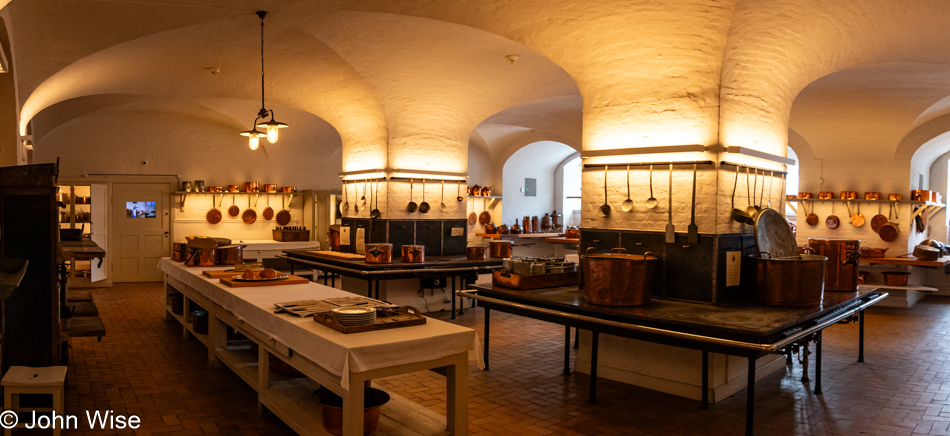
The palace kitchen is nothing more than an exhibit these days as with Foodora, Wolt, and maybe even Ubereats delivering, why would anyone keep a kitchen larger than 10 McDonald’s kitchens operational? Hello, this is Dominos; I see that you are calling from the Queen’s number. Would you like the usual?

This is Christian IV’s Brewhouse, first opened in 1608, that now serves as the Lapidarium of Kings, a home for statues. Open Wednesday through Sunday from 1:00 to 5:00 p.m. during the month of July, that’s it. This concept of making tourism compatible with seasons and the local population is a peculiar thought.
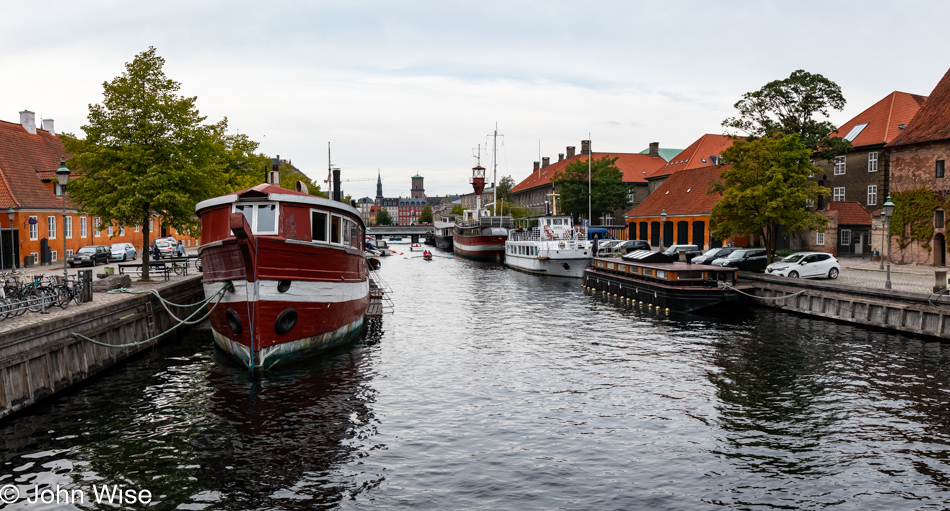
Last night’s walk took us northerly toward the Little Mermaid; this late day, we are heading in a southerly direction.

We briefly discussed a visit to Tivoli Gardens across the street from this statue of Hans Christian Andersen that Caroline has snuggled into. He’s looking up at the sign for Tivoli. It seems that almost everyone we’ve spoken with before and during this trip has asked if we’ll be visiting, but we can’t see the draw, and even if everything else is closed, there must be something better to do.

Yesterday, following the vegans in protest brought us to the edge of city hall across from Tivoli, but we were more interested in visiting the Round Tower, so we missed details such as these, and yet again, we are pulling ourselves away from this square as we’ve decided on what’s ahead.

First, we’ll need a tram to the Nørrebro Street station.

Next, Harry’s Place, which I’d first heard of from foodie YouTuber Mark Wiens. We were here to try their crispy pork sandwich, and it certainly was great, but it turns out that they are really famous for their hot dogs boiled in beef tallow, which makes them super crispy. While we were already stuffed, the woman behind the counter convinced us that life would be incomplete if we didn’t stuff one of these giant wieners down our gullets. Hanging out for a while with our host, we learned how the founder first gathered traction by getting a lucrative contract to serve his hot dogs at the local prison (the crispy sausages are called “Børge” after a local jailer), and from there he continued to gather steam. And the woman, whose name is forgotten, well, she’s been to 41 of the Roskilde Festivals that have been taking place since 1971, and sadly, I’ve never been to one of them, though I lived only 400 miles south of Roskilde, Denmark.
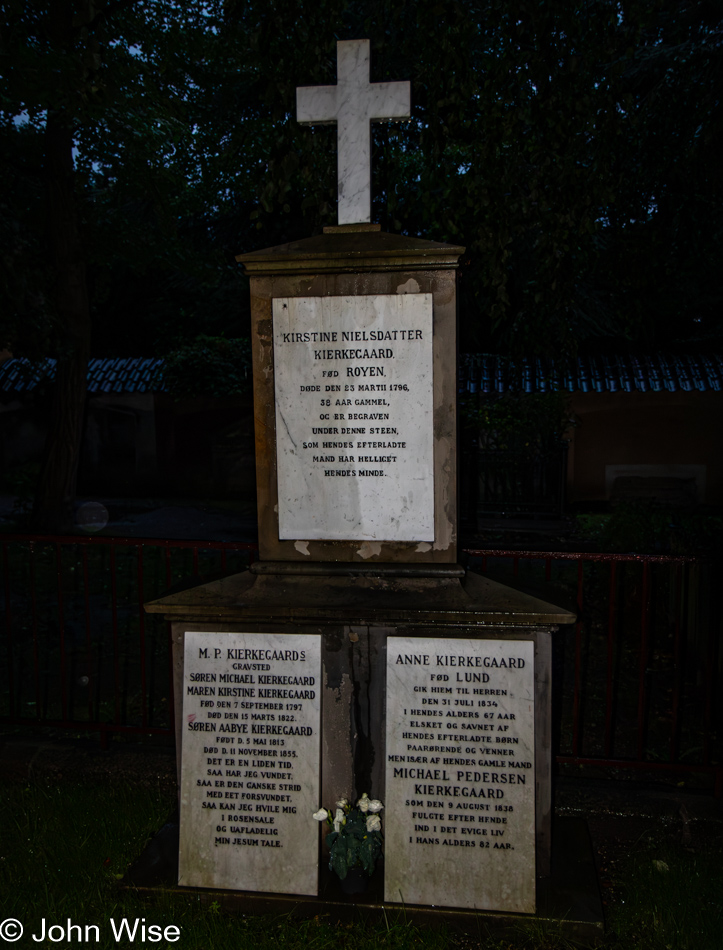
Though it had been raining when we arrived at Harry’s Place, it had stopped before we were done, and so we calculated on our good luck that we’d make our next and final destination of the day before it started raining again because the heavens often smile upon us. Bad calculation here, but it was really nothing more than a light sprinkle of moisture, so we were good until we stepped into the Assistens Kirkegård (cemetery). Our puny umbrellas did little during the increasing downpour, but we were already in the cemetery and here to see the graves of Hans Christian Andersen, Niels Bohr (we’d recently seen the movie Oppenheimer), and Søren Kierkegaard. My photo of Andersen’s grave just didn’t work out, so we gave up on the idea of seeing Bohr’s because after getting a reasonable image of Kierkagaard’s final resting place, the celestial onslaught combined with the increasingly close lightning strikes had us sprinting (as much as older people sprint in the dark) across the cemetery trying to avoid the puddles growing in the middle of the paths. Between laughter and minor frustration that we put ourselves out here with nowhere to find cover, we finally made it to the edge of the cemetery, where an underground metro stop was about to return us to Orientkaj, bringing our day in Copenhagen to a close.